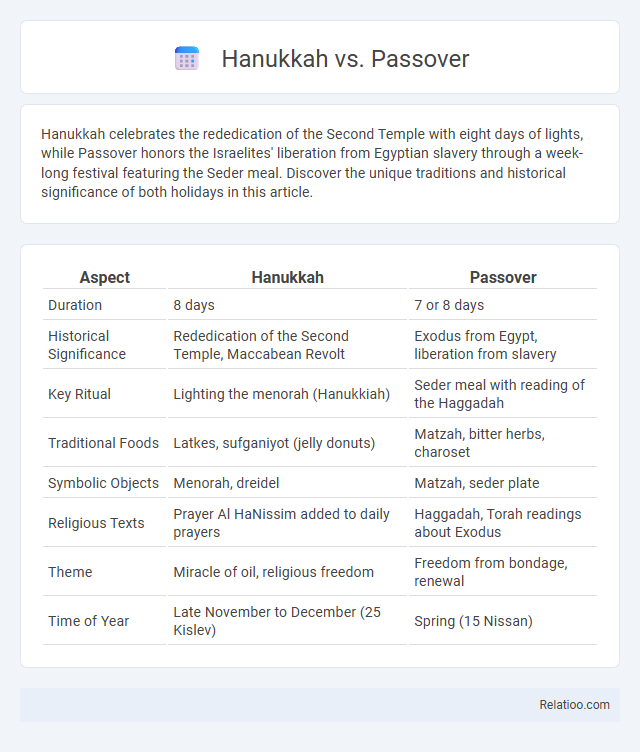Hanukkah celebrates the rededication of the Second Temple with eight days of lights, while Passover honors the Israelites' liberation from Egyptian slavery through a week-long festival featuring the Seder meal. Discover the unique traditions and historical significance of both holidays in this article.
Table of Comparison
| Aspect | Hanukkah | Passover |
|---|---|---|
| Duration | 8 days | 7 or 8 days |
| Historical Significance | Rededication of the Second Temple, Maccabean Revolt | Exodus from Egypt, liberation from slavery |
| Key Ritual | Lighting the menorah (Hanukkiah) | Seder meal with reading of the Haggadah |
| Traditional Foods | Latkes, sufganiyot (jelly donuts) | Matzah, bitter herbs, charoset |
| Symbolic Objects | Menorah, dreidel | Matzah, seder plate |
| Religious Texts | Prayer Al HaNissim added to daily prayers | Haggadah, Torah readings about Exodus |
| Theme | Miracle of oil, religious freedom | Freedom from bondage, renewal |
| Time of Year | Late November to December (25 Kislev) | Spring (15 Nissan) |
Understanding Hanukkah and Passover: An Overview
Hanukkah commemorates the rededication of the Second Temple in Jerusalem and the miracle of the oil lasting eight days, traditionally observed over eight nights with lighting the menorah, playing dreidel, and eating fried foods. Passover celebrates the Exodus from Egypt, emphasizing themes of liberation, with rituals including the Seder meal, reading the Haggadah, and avoiding leavened bread (chametz) for seven or eight days. While Hanukkah falls in late November to December and centers on religious freedom and miracles, Passover occurs in March or April, focusing on historical deliverance and cultural renewal.
Historical Background: Hanukkah vs Passover
Hanukkah commemorates the rededication of the Second Temple in Jerusalem during the Maccabean Revolt against the Seleucid Empire in the 2nd century BCE, highlighting Jewish resistance and the miracle of the oil lasting eight days. Passover marks the Exodus from Egypt over 3,000 years ago, symbolizing liberation from slavery and the birth of the Israelite nation under Moses' leadership. Understanding these distinct historical backgrounds enriches your appreciation of their unique cultural and religious significance in Jewish tradition.
Core Religious Significance of Each Holiday
Hanukkah commemorates the rededication of the Second Temple in Jerusalem and the miracle of the oil lasting eight days, symbolizing divine intervention and Jewish resilience. Passover celebrates the Exodus from Egypt and liberation from slavery, emphasizing themes of freedom, redemption, and divine deliverance. The Date fruit holds significance in Jewish tradition as a symbol of sustenance and blessing, often associated with the Feast of Tabernacles (Sukkot) rather than Hanukkah or Passover.
Key Traditions and Rituals Compared
Hanukkah traditions center on lighting the menorah for eight nights, reciting prayers like the Hallel, and playing with the dreidel, symbolizing the miracle of the oil lasting eight days. Passover rituals emphasize the Seder meal, where participants retell the Exodus story, eat matzah, and observe dietary restrictions to commemorate liberation from slavery in Egypt. Dates play a crucial role as symbolic foods in various festivals, including Passover, representing sweetness and renewal, while also featuring in Hanukkah treats, linking historical significance with cultural practices.
Hanukkah Symbols vs Passover Symbols
Hanukkah symbols include the menorah, dreidel, and gelt, each representing the miracle of the oil, festive play, and holiday gifts, respectively. Passover symbols such as the Seder plate, matzah, and maror highlight the story of the Exodus, the unleavened bread, and the bitterness of slavery. These distinct symbols reflect the unique historical and religious significance of each Jewish festival.
Traditional Foods of Hanukkah and Passover
Hanukkah features traditional foods like latkes and sufganiyot, fried treats symbolizing the miracle of the oil lasting eight days in the menorah. Passover centers around matzah, unleavened bread that commemorates the Israelites' hasty escape from Egypt, and dishes like charoset and bitter herbs which embody elements of the Exodus story. Your celebration menu highlights these unique foods, differing significantly by holiday while preserving rich cultural and religious significance.
Duration and Timing in the Jewish Calendar
Hanukkah lasts eight days, typically occurring in late November to December, commemorating the rededication of the Second Temple. Passover spans seven or eight days in early spring, usually March or April, marking the Exodus from Egypt and the liberation from slavery. Your understanding of these holidays' durations and timing highlights their distinct roles within the Jewish calendar and cultural heritage.
Family Activities and Community Events
Hanukkah features lighting the menorah, playing dreidel, and enjoying traditional foods like latkes, creating festive family gatherings that strengthen bonds. Passover centers on the seder meal, where families collectively retell the Exodus story, fostering a strong sense of heritage and community participation through group readings and shared rituals. Your celebrations can be enriched by attending community Hanukkah parties or Passover seders, both offering opportunities for social connection and intergenerational learning.
Modern Celebrations and Global Observance
Hanukkah celebrations in modern times often include lighting the menorah, playing dreidel, and enjoying traditional foods like latkes, observed worldwide by Jewish communities. Passover features family Seder meals retelling the Exodus story, with dietary restrictions observed globally, highlighting its significance in Jewish cultural identity. Both holidays have seen increased global recognition, with communities adapting rituals to contemporary settings and promoting inclusivity across diverse populations.
Hanukkah vs Passover: Cultural Impact and Legacy
Hanukkah and Passover each hold profound cultural significance within Jewish tradition, with Hanukkah commemorating the rededication of the Second Temple and the miracle of the oil lasting eight days, while Passover celebrates the Israelites' liberation from Egyptian slavery. Hanukkah's legacy is marked by themes of religious freedom and resilience, often attracting widespread observance through menorah lighting and communal gatherings, particularly in the diaspora. Passover's cultural impact centers on themes of liberation and identity, highlighted by the Seder meal and the retelling of the Exodus story, creating a deeply rooted sense of heritage that shapes Your connection to Jewish history and values.

Infographic: Hanukkah vs Passover
 relatioo.com
relatioo.com